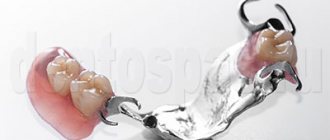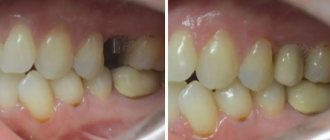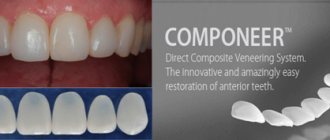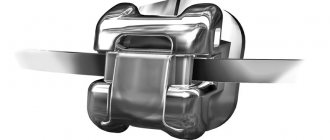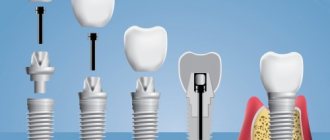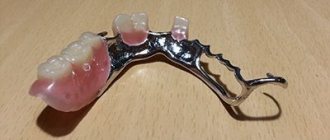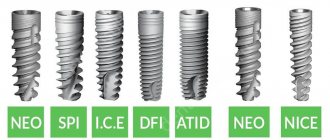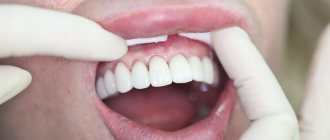Content
hide
1 Features of clasp dentures
2 Are there any disadvantages to clasp dentures?
3 What features do implants have?
4 What to choose: clasp prosthesis or implant?
If prosthetics are necessary, patients are concerned about the issue of choice. For example, in case of terminal defects of the dentition (lack of outer teeth), it is necessary to decide what to choose: a clasp denture or the installation of implants. There are many opinions from both patients and dentists on this matter. But you need to be guided by clear facts about these types of treatment. Let's look at the techniques in more detail.
Features of clasp dentures
First of all, why is the prosthesis called that? Bugel is a German word meaning “arch”, in the form of which the base for the prosthesis is made. The prosthesis is removable and must be removed daily for hygiene procedures.
The frame for the prosthesis is a metal arch, on top of which a layer of plastic (acrylic) is applied. The design is reliable and can function for about ten years. A clasp denture is made while preserving at least 6–8 natural teeth. The prosthesis is attached to these teeth. There are different types of fastening. These include:
- clasps (hooks);
- attachments (locks);
- telescopic mounts.
The choice of fixation method depends on the clinical picture, the wishes of the patient and the characteristics of the oral cavity.
Subtleties of care
In order to extend the service life of a clasp prosthesis with locks, it is necessary to comply with the conditions of its operation. It is enough to follow simple rules:
- After each meal, rinse the structure with clean boiled water.
- Clean the denture twice a day using a toothbrush and paste, as well as a special antiseptic solution.
- Visit your dentist regularly for professional cleanings and preventive examinations.
- Avoid too hot food and drinks, chemical and mechanical effects on the prosthesis.
- If necessary, make timely repairs and corrections.
Are there any disadvantages to clasp dentures?
Of course there is. Many patients do not like the fact that they have to be removed periodically. Installation of a prosthesis is possible only after preliminary preparation of your teeth (grinding, if necessary, depulping, covering with crowns, etc.). Abutment teeth are subjected to severe stress, which can destroy them over time. Some types of fixation are noticeable at close range. The chewing load is distributed between the supporting teeth and gums. After prolonged use, bone tissue atrophy occurs in the area of missing teeth.
In addition, there is a risk of the patient developing an allergic reaction to the metal from which the prosthesis frame is made.
And, of course, it takes gradual getting used to the dentures - at first they are very noticeable in the mouth. And any deviation from physiology in the oral cavity causes discomfort.
Varieties
Clasp dentures have different fixations on the remaining teeth. They can be on clasps, on locks and on telescopic crowns. Various prosthetic fixation systems have both advantages and disadvantages, and at the moment we will tell you about both.
Clasp dentures with clasps
This design is fixed using hook-clasps, which very tightly clasp the abutment tooth. Clasps are made of metal. With their help, the denture is firmly held on the jaw and, when chewing, transfers the load to the teeth. In most cases, clasps are cast together with the frame, so this design is highly strong and durable. Clasps are selected individually in accordance with the size and shape of the teeth.
Clasp dentures with locks also have differences in cost: One-sided clasp dentures are used in the case of a one-sided lack of dentition, with contraindications for dental implantation, in the absence of the ability to produce a fixed bridge prosthesis, and in some other cases. Most professionals and professionals in the field of dentistry believe that that at present there is no candidate for clasp dental prosthetics. Now clasp dentures are managed at the appropriate level with their main tasks - the restoration of lost chewing functions and the creation of the cosmetic effect of healthy teeth.
Clasp dentures with locks
Clasp dentures with locks have a strong, lightweight bridge-like structure, which, when chewing, transfers some of the pressure to the supporting teeth. To protect and strengthen the abutment teeth, they are previously covered with metal-ceramic crowns, into which half of the lock is inserted, and the other half is placed on the abutment teeth. When installing the prosthesis, the lock snaps into place.
Locks fixed in the teeth or in the crowns of the teeth provide the highest strength of the prosthesis. In addition, they allow you to firmly fix the structure and simply remove it for repeated cleaning.
They have clasp dentures with locks and several shortcomings. One of them is the complexity of production. Currently, in dental prosthetics, this is the most high-tech design, the production of which requires the highest qualifications of a dental technician and an orthopedic doctor. In the manufacture of such a prosthesis, the highest accuracy of calculation of all parts of the structure is essential.
This leads to the second drawback - the highest price. Their effectiveness in comparison with other types of prosthetics is expressed in the comfort of wearing such a denture and comfortable eating. In addition, they are reliable and have a long service life. The cast iron frame is the main difference between the clasp type of prosthesis and the plastic one. Artificial teeth and a plastic base are fixed to this frame.
Caring for a clasp denture
Also, in each individual case, the cost of a clasp denture will depend on the type of fixation of the prosthesis to the teeth. Clasp prosthetics with locks are an order of magnitude more expensive, because in this case the total price also includes the cost of locks and metal-ceramic crowns.
Clasp dentures have a different price range: It is very comfortable, convenient and comfortable from the mental side. All you need to do is remove the prosthesis often and do ordinary hygiene procedures. Take care of your own clasp denture, then you will never complain about the appearance of stomatitis, changes in speech and discomfort when chewing.
Price of clasp prosthetics
Nowadays, one of the most popular types of dental prosthetics is clasp prosthetics, the price of which depends on different clinical situations. There are ordinary and complex clasp dentures. Complex clasps have a system of clasps; they may have not one, but two iron arcs.
The next difference is the cost. The cost of installing clasp dentures is determined by many reasons. Before creating and installing a partial denture, the dentist prepares the oral cavity: cures the teeth, removes plaque, replaces the supporting teeth with crowns and takes impressions of the teeth. These works should be taken into account; otherwise, the expected cost of prosthetics may actually turn out to be significantly higher.
The clasp denture completely complements the dentition. But artificial teeth, just like natural teeth, require careful care. Caring for a clasp denture is not difficult; you don’t even have to take it off at night.
- conventional clasp prosthesis – from fifteen thousand rubles.
- complex clasp prosthesis – from 20 thousand rubles.
- clasp splinting prosthesis – from 20 thousand rubles.
Thus, clasp dentures with clasps are a good option for dental prosthetics, which has only one drawback - low aesthetics. When you grin, iron hooks may be visible in your mouth. But this applies only to individual cases when installing a prosthesis using another method is simply clinically impossible. It should be noted that the price of this type of prosthesis is higher compared to its plastic counterparts.
- regular clasp prosthesis – from 50 thousand rubles. (with all this, the price already includes the cost of the prosthesis, locks and 4 crowns);
- one-sided clasp prosthesis – from 30 to 5 thousand rubles. (with all this, the price already includes the cost of the prosthesis, 2 crowns and locks).
What features do implants have?
Implantation involves installing a special titanium pin (artificial root) into the bone tissue in place of a missing tooth. The implant is the basis for the subsequent manufacture of crowns, bridge structures, and various prostheses.
Over a period of 3 to 6 months, the implants take root (fuse with the surrounding tissues). The implant itself is located under the gum and is not visible. A special transitional part (abutment) and an artificial tooth crown “stick out” from the outside, which is made only after the implant has healed.
This treatment method is effective; implants usually last for several decades. If you follow your doctor's recommendations, the implant can last a lifetime.
Advantages of this type of treatment:
- reliability and longevity;
- adjacent healthy teeth are not ground down;
- after tooth loss, implantation helps to avoid bone tissue deformation and facial features;
- Fixed crowns can be made for implants;
- The function of the tooth is restored completely and allows you to lead a full life.
Like any procedure, implantation has its drawbacks. There are a number of contraindications that make implantation impossible.
Some patients are not satisfied with the fact that before making crowns for implants, it is necessary to wait for their implantation (3-6 months).
Another feature of this procedure is its high cost. It is due to expensive materials, the need to use special tools, and the technical complexity of the installation. Sometimes, installing an implant requires bone tissue augmentation, which further increases the cost and duration of treatment.
Advantages
Clasp dentures are often the choice of experienced dentists and their patients. All this is explained by the large number of advantages of such removable systems. Among them:
- reasonable cost of clasp dentures, affordable for most patients;
- ease;
- Duration of use - more than 5 years;
- ease of care;
- uniform distribution of chewing load;
- the possibility of further unhindered dental treatment if necessary;
- small thickness, compact size;
- when installed on the lower jaw, the prosthesis leaves quite a lot of space for free movement of the tongue;
- strength and reliability of the metal frame;
- when installed on the upper jaw, it does not distort the bite, diction and does not interfere with the fullness of tastes.
Prosthetics with clasp dentures are recommended for:
- the need for bite correction;
- increased abrasion of enamel;
- missing dental units, to restore a row;
- existing defects in the smile area.
It is prohibited to install a clasp system if there is:
- allergic reactions in the patient to anesthesia;
- diseases associated with the central nervous system;
- exhaustion of the body;
- lack of supporting teeth for which the prosthesis could be hooked.
What to choose: clasp denture or implant?
As you can see, a more physiological option is to install implants. This option also provides complete restoration of the function of a lost tooth. If you focus on aesthetics, this option also wins.
Clasp dentures are also a modern, high-quality method of removable prosthetics. But, if we compare them with implantation, they win only in terms of the financial part of the issue. They can also be preferred in situations where implantation is impossible for some reason.
In any case, it is better to make the final decision after consulting a dentist. He will determine whether there are any contraindications or other health conditions and will select the optimal treatment option.
On telescopic crowns
This method of prosthetics is very common abroad. The supporting teeth are ground down, then metal caps are attached to them using cement. Two crowns are placed on the prosthesis frame. When put on, they are inserted on top of the caps.
The design is invisible during a conversation, evenly distributes the chewing load and is well fixed. This is the most expensive design to install.
What to do, if
- Nausea because of dentures
. During attacks of nausea, it is recommended to make frequent swallowing movements. Peppermint candies help a lot. They are absorbed, but under no circumstances are they chewed. - There is a strong gag reflex
. Recommendations include the same lozenges and deep, calm breathing. Relaxation occurs faster if the exhalation is longer than the inhalation. For example, inhale for a count of 4, and exhale for a count of 6. You can put salt water in your mouth. You don't need to swallow it, just hold it for a while and spit it out. If nothing helps, you need to see a doctor. He will either make a correction or prescribe special medications. - A lot of saliva is produced
.
This is a temporary phenomenon and will go away in 1-2 days
. And here sweets that you can suck for a long time come to the rescue. The brain will associate salivation with candy rather than with a fake jaw. - The prosthesis rubs
. You need to go to the dentist and have an orthopedist make a correction. You cannot file the structure yourself, as this can lead to damage to the restoration. Before visiting the dentist, the denture must be left in place for at least 3 hours so that the doctor can see the places where the restoration is rubbing.
Leading manufacturers and cost
One of the best laboratories specializing in the manufacture of clasps is AlvaDent. The company is located on the territory of the Russian Federation; Swiss equipment is used for production, guaranteeing product quality.
Ball-shaped fasteners used for fixing clasp dentures on attachments are produced by the Italian concern Rhein-83 and the German company Bredent.
The company CENDRES & METAUX SA DENTAL, located in Switzerland, produces hinged and locking fasteners. An improved locking system was developed here, including 6 types of lock mechanism matrix and one patrix. From this organization you can order semi-labile, labile, beam and rigid spherical attachments.
The price of clasp dentures starts from 45 thousand rubles and depends on the type of product being installed, the clinic and the condition of the patient’s teeth.
Manufacturing stages
Prosthetics consists of the following stages:
- Examination and examination of the patient;
- Making a diagnosis, selecting an orthopedic design;
- Preparation of the oral cavity – professional cleaning, sanitation;
- Taking dental impressions;
- Manufacturing of structures in a dental laboratory;
- Trying on a clasp, choosing a fixation method, teeth color;
- Fixation of the finished product;
- Advice and recommendations for the patient.
